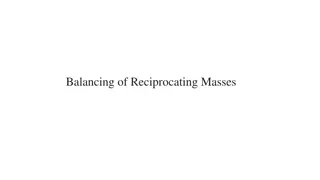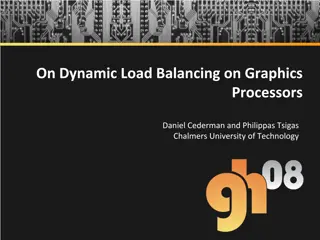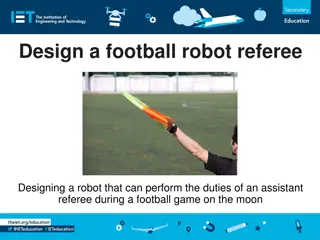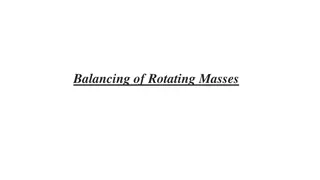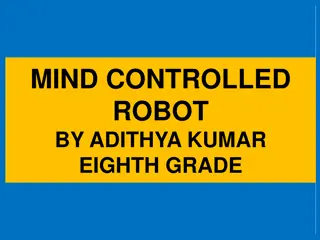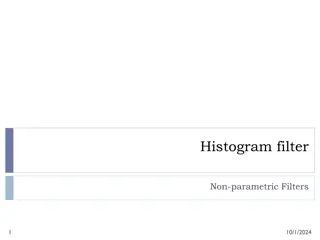Design Project: Biped Robot Balancing and Movement
This design project focuses on creating a biped robot for balancing and movement on various terrains. The robot features autonomous capabilities and wheels for stability, allowing it to move in all directions. Control is achieved through uploaded instructions. The project includes detailed design descriptions, bill of materials, and functional requirements to meet customer expectations for a versatile and durable robot.
Download Presentation

Please find below an Image/Link to download the presentation.
The content on the website is provided AS IS for your information and personal use only. It may not be sold, licensed, or shared on other websites without obtaining consent from the author.If you encounter any issues during the download, it is possible that the publisher has removed the file from their server.
You are allowed to download the files provided on this website for personal or commercial use, subject to the condition that they are used lawfully. All files are the property of their respective owners.
The content on the website is provided AS IS for your information and personal use only. It may not be sold, licensed, or shared on other websites without obtaining consent from the author.
E N D
Presentation Transcript
BIPED ROBOT FAHAD MOHAMMED NAIF SPONSOR: PROGRAM FEES
INTRODUCTION The is a Design project to make a robot which provides a sufficient way to Balancing Robot An Autonomous Robot with the Wheels to balance on rough and tough terrains With the help of wheels, it can move in all the directions on different terrains to show the balancing. Control the Robot through the instructions uploaded in its system Project Sponsored by: PROGRAM FEES
DESIGN DESCRIPTION 3D CAD MODEL Has developed
BILL OF MATERIAL Bill of Materials Team Qt y # Part Name Description To do the movement in each direction Cut the sheet to make the robot sides Functions Do the walking, dancing, balancing Form the structure of robot Pass the signals to each part Connect with Arduino to pass signals Make the connection with Controller Material Dimensions Cost Link to Cost estimate 1Servo Motor 6 Steel 1.2 x 1 in 100 x 100 mm $82.74 Ebay 2Steel Sheet 4 Steel $38.32 Ebay 3Arduino 1Control the Robot motors Silicon 4 in x 4 in $3.49 Ebay 4Controller Blue Smurft Bluetooth 1Control the robot wirelessly Connect control with Arduino Make conneciton with motor and Plates To hold the items on the board 50Make the connections Provide power to arduino and motors Plastic 6 x 4 in $27.99 Ebay 5 1 Silicon 4 in x 4 in $27.99 Spark Fun 6Strap Hinges High gloss Tape 8Screws 12 Put on the joints Grip all the parts over the robot Hold the joints with hinges Steel Generate the electricity from storage Steel 2 in x 4 in $26.28 Ebay 7 1 Vinyl PVC 4 x 2 in 0.5 x 0.1 in $139.49 Ebay $1.14 Ebay 9Battery 2 Li-Ion 4 x 2 in $97.50 Ebay
BILL OF MATERIALS Bill of Materials Team Description Controller power Connect between the parts Battery 10 # Part Name Cells Jumper Wires Power Adopter 4 Functions Provide power to the controller Li-Ion Make all the connection for supply Provide the charging to the robot battery Dimensions 3 x 1 in Link to Cost estimate $11.96 Ebay Qty Material Cost 11 4 Copper 6 x 0.1 in $4.00 Ebay 12 1 To charge the battery Plastic 4 x 2 in $14.59 Ebay Total $475.49 Total incl. tax $556.32
DESIGN FUNCTIONS Wheeler Robot Balancing Move Forward Move Backward Stable in all directions Increase and decrease the speed
DESIGN REQUIREMENTS Customer Requirements Wheeler Robot Reciprocal Linear Mechanism Forward and Backward Motion Safe to Use Remotely Control Long battery backup Smooth Transition Racing speed can control Capable of Balancing in all directions Perform dancing Reliable Long lasting Durable
DESIGN REQUIREMENTS The Robot Design is Wheeler Design so the first requirement has fulfilled Reciprocal Linear Mechanism requirement has fulfilled using the motors that directly operate the wheels with the help of a gear system Forward and Backward motion requirement has fulfilled as the robot can move forward and backward with the help of wheels The Robot is safe to use because no sharp edge is present so the requirement has fulfilled Remotely Control the Robot requirement: Autonomous robot but the instructions will pass to the Robot using the remote so remote control access
DESIGN REQUIREMENTS Long Battery Backup: Use of high power battery for long battery backup A Smooth transition is fulfilling because of wheels using in it and also the smooth transition can be seen Racing Speed can control as the speed of forwarding and backward motion can control so this requirement is fulfilling Balancing in all directions using the gyroscope so fulfilled this requirement by the design Perform Dancing: This requirement has not yet decided to fulfill or not
DESIGN REQUIREMENTS Reliable: As the design is strong and motors will use good quality to make it reliable so this requirement is fulfilled. Long-Lasting or Durable: Steel will use to develop the outer body that will be long-lasting so this requirement was fulfilled. Almost all the requirements have fulfilled by the design only the dancing capability has not decided yet and also dancing is not an important aspect for the balancing rob
DESIGN REQUIREMENTS Dimensions ? = 20 ?? ? = 6 ?? ???? = ? ? ???? = 20 6 ???? = 120 ??2 Hence the required area is also 120??2so this requirement has fulfilled as well
DESIGN REQUIREMENTS Moving Capacity ? = 180 ??? Consider the velocity of robot is ? = 0.3? ?2 So the distance it can travel using the time of 180 seconds ???????? = ? ? ???????? = 0.3 180 ???????? = 54 ? So it can easily travel 54 meters and we need the capacity of 3 meters only so hence this ER has fulfilled as well
DESIGN REQUIREMENTS Battery Time Calculation: ??????? ???????? = 60 ??? ? =? ? ? = 1 ? = 1000 ?? 60 1000 ? = ? = 0.06 ????? ? = 0.06 3600 = 216 ??????? So the battery will run for around 216 seconds and we need running time of 180 seconds so engineering requirement has tested and fulfilled
DESIGN REQUIREMENTS Analytical Analysis for Wheel Shaft For shaft connecting two wheels can be a hollow shaft or solid shaft. And it can determine using the following equation ?2= 0.5 ????? ? ? ? ?2= 0.5 ????? ? ? ? Putting the values into the above equation ?2= 44% Results have shown that the strength to weight ratio of hollow shaft is higher than the strength to weight ratio. By 44% which means hollow shaft is better to use and it will light in weight which is better for the design and strong enough to cover the whole body weight.
DESIGN REQUIREMENTS Material Analysis Aluminum Alloy 6061 Body Steel Body Ultimate Strength of Aluminum 6061 = 290 Mpa Ultimate Strength of Steel = 400 Mpa Strength to Weight Ratio of Aluminum = 42 ksi Strength to Weight Ratio of Steel = 126 ksi Strength to Weight Ratio of Aluminum = 1 3Strength to Weight ratio of Steel Aluminum is preferable to use because of light weight and high strength
FMEA ANALYSIS Potential Effect(s) of Failure Severit y (S) Potential Causes and Mechanisms of Failure Occurrenc e (O) Current Design Controls Test Detection (D) Recommended Action Part # and Functions Potential Failure Mode RPN 1. opposite force to the joint Putting load on the joint Strong Connect 1.1 Aluminum Sheet steering and net tension Joint Leakage 5 3 2 30 cracks on the sheet, destruction of sheet Unable to un screw it, unable to screw properly Half Unbale to screw the boards, Extra costs, wastage of time and resources purpose of device failed, extra cost addition 1.2 Aluminum sheets Extra load on sheet, No support for the sheet Checking the stress on the sheet Tensions and breakage 6 4 3 72 None 1. Low quality manufacturing 2. Non use of proper tools 1. Stress testing for screw 2. Use of various quality tools Breakage of screw, Destruction of the screw cap 2.1 screw 8 1 2 16 None 1. Testing with various types of screws 2. voltage change test 1. Over heating 2. Improper voltage 3. over use Extra speed of gun, burning of motor 3.1 screw gun 3 2 3 18 None 1. bad quality of copper 2. poor windings 3. over voltage, over speed 1.Bad quality due to molding, 2. poor quality shaft is used Burning of motor, dislocation of wings angle Check multiple fans and test them roguishly 1. Speed test 2. Over voltage test 3.2 Motor 6 4 8 192 Test various qualities if pipes available at same cost wait for new shaft, cost increased Bending of Shaft, Breakage of Shaft 1.Bad seeding, Poor Quality aluminum 4.1 Shaft 7 4 6 168
FMEA ANALYSIS Potential Effect(s) of Failure Severit y (S) Potential Causes and Mechanisms of Failure Occurrenc e (O) Current Design Controls Test Detection (D) Recommended Action Part # and Functions Potential Failure Mode RPN usefulness will be lost, power will be wasted, less back of power 1. Testing with various types charging screws up will be available 2. will change test 1. No power backup will be available 2. wind energy will be wasted Overcharging, no charging, discharge too quick try to place charging circuit 3.11 chargeable batteries 4 6 2 48 start will not work, changing the rubber will be extra costly breaking of rubber start, bending, changing shape due to temperature 5.1 rubber Wheels 6 1. start will not work 4 1. rubber stress test 7 168 None moisture will increase and short-circuit may occur 1. Structure extreme weather conditions tests silicon breaking, strand weakness 1. Robot will loose control 5.2 Silicon board 3 3 5 45 None Robot will not able to move and cause extra cot Test in extreme conditions and loads angle changes, breakage, changing load on turbine Wheels will not move in a line 6.1 Wheel Rims 9 8 1. Efficiency lost 8 576
DESIGN VALIDATION Risk Trade-Off Analysis Risk Trade-Off analysis has shown that we need to trade with the weight to get the maximum result from the Robot Weight is a critical part of the design but increasing a little bit of more weight can gain can us much more efficiency and accuracy. From the analysis Increase of weight by 2 lb. can provide the speed up to 5 m/s^2 So an increase of 40% in the weight can get around 800% increase in speed because of adding extra powerful motor which can support the rotation and provided high torque.
TESTING PROCEDURES Dimensions The Area can test using the foot scale Multiply the width and height to get the area Battery Time Battery time can test by running the battery with the motors with full load and use the time clock to record the total battery time Walking Length Capacity The Capacity of moving for the robot can test by measuring the distance using the meter scale Height Height will test using the foot scale.
TESTING PROCEDURES Wheel Radius The radius of the wheel can also test using the foot scale. Degree of Freedom It will test by counting the motors and then check with the naked eyes how many motors are using DOF Width It will also test using the foot scale
BUDGET Budget Total Budget $1500 Estimated Budget $556 Prototype Cost $450 Contingency Budget $344 Travelling etc. $150
REFERENCE [1] https://www.ebay.com/itm/360-20KG-Waterproof-High-Torque-Metal-Gear-RC-Servo-Motor-Car-Helicopter-Boat/ [2] https://www.ebay.com/itm/STAINLESS-STEEL-SHEET-PLATE-in-Various-sizes-and-Thickness/112740090156?var=413195179173&hash=item1a3fd5412c:m:mPUwwyOw159DWFCKTJz7fqA [3] https://www.ebay.com/itm/Arduino-UNO-R3-Mini-Micro-USB-ATmega328P-CH340G-Replace-ATmega16U2-Board/20192795 [4] https://www.ebay.com/itm/PS4-DUALSHOCK-4-Wireless-Controller-Bluetooth4-0-Gamepad-for-SONY-PlayStation-US/123895207849?hash=item1cd8bad7a9:m:mL4D1NtKRZ7718d31_Ts2fg [5] https://www.sparkfun.com/products/12577 [6] https://www.ebay.com/itm/Strong-Heavy-Duty-Strap-Hinges-Zinc-Tee-Door-Gate-GOLD-Choose-your-pack-size/142432290165?hash=item2129a04575:m:mRej1rysKMpJj9NQ2h7a8MA [7] https://www.ebay.com/itm/Multicolor-Adhesive-High-Gloss-Film-Vinyl-PVC-Tape-Automotive-Grade-Car-Wrap/223034541877?var=521843692188&hash=item33ede50735:g:6qEAAOSwi5dcl0Qt [8] https://www.ebay.com/itm/M3-Black-12-9-Grade-Alloy-Steel-Allen-Hex-Socket-Cap-Head-Screw-Bolt-DIN912/182022519670?_trkpar [9] wheel/123902060267?_trkparms=aid%3D555018%26algo%3DPL.SIM%26ao%3D1%26asc%3D6 https://www.ebay.com/itm/4-4Ah-4400mah-36v-18650-lithium-battery-pack-for-Balance-Scooter-Board-2- [10] https://www.ebay.com/itm/Safest-3-7V-18650-Charger-Lithium-Ion-Battery-USB-Rechargeable-Battery- Universal/153613634183?_trkparms=ispr%3D1&hash=item23c4160a87:m:m_p07jw_b4GxCYAdeRoJrZQ&enc=AQAEAAA [11] https://www.ebay.com/itm/10-20-30CM-Jumper-Wire-Cable-Male-to-Male-to-Female-to-Female-Arduino-Breadboard/392315907400?_ [12] https://www.ebay.com/itm/AC110-220V-Power-Supply-Adapter-Transformer-LED-Strip-2A-3A-5A-8A-DC-5V-12V-24V/322286626497?_trkparms=ispr%3D1&hash=item4b09c7a6c1:m:mQ3El- m3_vZFy4IcfeV7aTg&enc=AQAEAAACMBPx
APPENDIX A SHAFT CALCULATIONS ? ?? ? ??? ?????? = ? ? = 72 ??? ? ??? ?????? =72 60 10 3 0.48 ? ??? ?????? = 9 ??? 2 2 3?? ? ??2 ? ? ? Now calculate the weight ratio first, ?1 ?2= ???2 ? ? ? 2 2 30.006 ? 0.0062 1 8050 9.81 ?1 ?2= ?0.0062 1 8050 9.81
APPENDIX A SHAFT CALCULATIONS ?1 ?2= 0.5556 3 0.4012 ro 0.5556 ro s1= max 2 L g Reducing the above equation yield to ?1= 0.7221 ????? ? ? ? So now put the values into the above equation 0.006 ?1= 0.7221 9 1 805 9.81 ?1= 4.93 10 6


